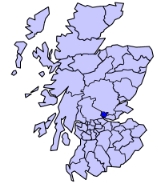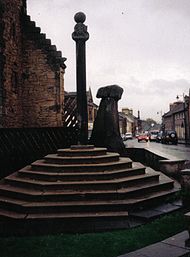
Clackmannan
Encyclopedia
| Clackmannan District 1975-96 | |
 |

- This article is about the administrative area, for the town see Clackmannan, ClackmannanshireClackmannan, ClackmannanshireClackmannan , is a small town set in the Central Lowlands of Scotland. Situated within the Forth Valley, Clackmannan is south-east of Alloa and south of Tillicoultry...
.
From 1975, Clackmannan (from the Gaelic
Scottish Gaelic language
Scottish Gaelic is a Celtic language native to Scotland. A member of the Goidelic branch of the Celtic languages, Scottish Gaelic, like Modern Irish and Manx, developed out of Middle Irish, and thus descends ultimately from Primitive Irish....
Clach Mhanainn, 'Stone of Manau') was the name of a small town and local government district in the Central
Central Region, Scotland
Central Region was a local government region of Scotland from 1975 to 1996. It is now divided into the council areas of Falkirk, Stirling, and Clackmannanshire, which had previously been districts within Central...
region of Scotland
Scotland
Scotland is a country that is part of the United Kingdom. Occupying the northern third of the island of Great Britain, it shares a border with England to the south and is bounded by the North Sea to the east, the Atlantic Ocean to the north and west, and the North Channel and Irish Sea to the...
, corresponding to the traditional county of Clackmannanshire
Clackmannanshire
Clackmannanshire, often abbreviated to Clacks is a local government council area in Scotland, and a lieutenancy area, bordering Perth and Kinross, Stirling and Fife.As Scotland's smallest historic county, it is often nicknamed 'The Wee County'....
, which was Scotland's smallest. The town of Clackmannan, in which the 'Stone' - a prehistoric monolith of probable cultic significance in the Iron Age
Iron Age
The Iron Age is the archaeological period generally occurring after the Bronze Age, marked by the prevalent use of iron. The early period of the age is characterized by the widespread use of iron or steel. The adoption of such material coincided with other changes in society, including differing...
- remains, was the chief settlement of its area from the Middle Ages
Middle Ages
The Middle Ages is a periodization of European history from the 5th century to the 15th century. The Middle Ages follows the fall of the Western Roman Empire in 476 and precedes the Early Modern Era. It is the middle period of a three-period division of Western history: Classic, Medieval and Modern...
(if not earlier), until supplanted from the second half of the 18th century by the growing manufacturing town of Alloa
Alloa
Alloa is a town and former burgh in Clackmannanshire, set in the Central Lowlands of Scotland. It lies on on the north bank of the Firth of Forth close to the foot of the Ochil Hills, east of Stirling and north of Falkirk....
, on the north shore of the Firth of Forth
Firth of Forth
The Firth of Forth is the estuary or firth of Scotland's River Forth, where it flows into the North Sea, between Fife to the north, and West Lothian, the City of Edinburgh and East Lothian to the south...
. The medieval castle of Clackmannan Tower (Historic Scotland
Historic Scotland
Historic Scotland is an executive agency of the Scottish Government, responsible for historic monuments in Scotland.-Role:As its website states:...
) stands above the town and is a landmark visible for many miles around. Dating from the 14th century, though much altered, the Tower is at present not open to the public, having been rendered dangerous by subsidence due to coal-mining (view from exterior).
The Stone of Manau stands by the mercat cross and the surviving tower and west gable of the former burgh tolbooth (built late 17th century) in the centre of the old town. Manau or Manaw was the name of the surrounding district in the Dark Ages.
The Local Government etc. (Scotland) Act 1994
Local Government etc. (Scotland) Act 1994
The Local Government etc. Act 1994 is an Act of the Parliament of the United Kingdom which created the current local government structure of 32 unitary authorities covering the whole of Scotland....
transferred the name to a unitary authority
Unitary authority
A unitary authority is a type of local authority that has a single tier and is responsible for all local government functions within its area or performs additional functions which elsewhere in the relevant country are usually performed by national government or a higher level of sub-national...
with the same boundaries, but the authority has subsequently re-adopted the traditional name of Clackmannanshire
Clackmannanshire
Clackmannanshire, often abbreviated to Clacks is a local government council area in Scotland, and a lieutenancy area, bordering Perth and Kinross, Stirling and Fife.As Scotland's smallest historic county, it is often nicknamed 'The Wee County'....
.
Bruce family of Clackmannan
Sir Thomas Bruce 1st Baron of Clackmannan was a member of the House of Bruce and received lands in Clackmannan from his cousin Robert IIRobert II of Scotland
Robert II became King of Scots in 1371 as the first monarch of the House of Stewart. He was the son of Walter Stewart, hereditary High Steward of Scotland and of Marjorie Bruce, daughter of Robert I and of his first wife Isabella of Mar...
Archaeological Excavation
Headland ArchaeologyHeadland Archaeology
Headland Archaeology comprises a holding company Headland Group Ltd and the trading subsidiaries Headland Archaeology Ltd, Headland Archaeology Ltd and Archaeological Investigations Ltd....
has recently completed an excavation of a prehistoric and medieval site at Meadowend Farm, Kennet. The site, which lies to the south-east of Clackmannan, is within the corridor for the new road and bridge across the River Forth at Kincardine. Over 2000 fragments of prehistoric pottery were recovered from the site. The vast majority came from a dense concentration of pits or postholes and has been dated to the middle/late Neolithic. A small polished stone axe was found in the area of the Neolithic pit concentration. A larger unpolished axe (c.150 mm in length) was recovered from a pit elsewhere on site. The majority of the pottery consisted of fragments, but one near complete vessel was excavated. The pottery showed a wide variety of incised and impressed decoration. There was also a number of shallow hearths in the area but no clear contemporary structures were identified on site.
At least 9 structures were identified on site. The most substantial of these was a large roundhouse with an outer ring-groove and an entrance to the south-east with an extended porch. Inside was a stone-lined hearth, and numerous pits and postholes. Many of these were rich in charcoal suggesting the structure may have burnt down. Prehistoric pottery has been recovered from the postholes dating to the middle/late Bronze Age. Two other ring-groove structures found on site were very heavily truncated. Two large post-built roundhouses were found, both with long porches, one with an entrance to the south-east, the other to the north-west. A third post-built structure contained a hearth-pit, which had been filled with fire-cracked stones and charcoal. It is hoped that radiocarbon dating will enable more precise phasing of the structures.
See also
- Clackmannan (UK Parliament constituency)Clackmannan (UK Parliament constituency)Clackmannan was a parliamentary constituency in the Clackmannan area of Central Scotland. It returned one Member of Parliament to the House of Commons of the Parliament of the United Kingdom, elected by the first past the post system....
- Subdivisions of ScotlandSubdivisions of ScotlandFor local government purposes, Scotland is divided into 32 areas designated as "council areas" which are all governed by unitary authorities designated as "councils"...
- Undiscovered Scotland

